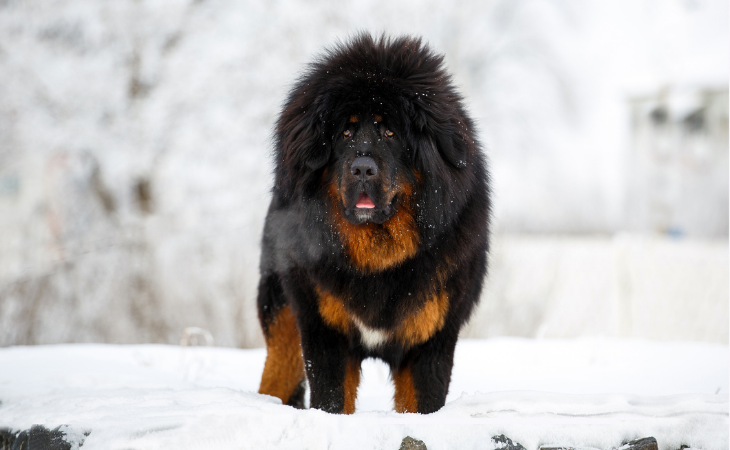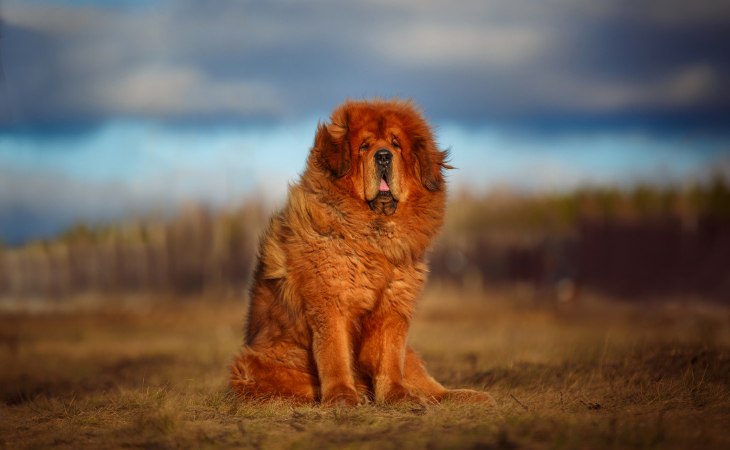Breed Standard: FCI I Size: Large I Average Lifespan: 12+ years I Personality: Independent, protective, and calm I Coat: Long I Origin: Tibet.
The Tibetan Mastiff is one of the largest dogs in the world. It is an exemplary guard dog and a loyal companion.
The origins of the Tibetan Mastiff
An ancient breed, guardian of temples and herds
It is believed that the Tibetan Mastiff is one of the oldest dog breeds in the world, appearing nearly 3,000 years ago in Central Asia. It is said to be the ancestor of other Mastiffs that we know today.
Quiet, observant and very intelligent, the Tibetan Mastiff used to help herdsmen in the Tibetan mountains. They also guarded monasteries and temples in the past.
There are not a lot of written recordings of this dog breed. It is said that Marco Polo brought back descriptions of an animal similar in strength and size to the Tibetan Mastiff. These dogs were especially trained for hunting.
It wasn’t until the end of the XIXth century that the first precise description of the Tibetan Mastiff first appeared when it was introduced in Europe. This dog was offered by the viceroy of India to Queen Victoria. The Tibetan Mastiff was loved by the Queen. The English also really loved the dog breed and bred them.
A prized dog breed
While the dog breed is not very well known in some parts of the world like France, it is very popular and well-loved in other countries. This is especially the case in China. For the last ten years, the Tibetan Mastiff has become the darling of millionaires, ready to spend large amounts of money to acquire one. However, this has also brought a share of bad practices, pushing many breeder to make random crossings, giving birth to sick, malformed and fragile puppies. Some owners also abandon them or offer them for sale in markets.
The Tibetan Mastiff’s personality
Observant, courageous and calm, the Tibetan Mastiff is a pleasant and loyal companion. However, this dog also has a strong personality. They are very independent, excellent protectors, and particularly disobedient.
Qualities
The main qualities of the Tibetan Mastiff are its calmness and its observative and protective nature. While they are not very affectionate, they are extremely loyal and wouldn’t stop at anything to keep their family safe.
They are very independent and refuse to follow orders without thinking. In addition, they are very respectful and serious.
The Tibetan Mastiff is not very active, contrary to what one could believe, however it prefers to spend time in the open air rather than locked up all day.
Are there downsides to having a Tibetan Mastiff?
The Tibetan Mastiff is gentle and calm, however, it is unpredictable and can be disobedient. It can even react impulsively if it has the slightest suspicion of danger. Also, their independence allows them to face loneliness without any problem. With that being said, the Tibetan Mastiff does not adapt easily to strangers or to young children.
The Tibetan Mastiff does not really get along well with children. This is because it is sensitive to sudden actions that it could interpret as a threat. Moreover, its large and imposing body could lead it to accidentally hurt a young child.
Because this breed is very solitary, the Tibetan Mastiff is not very affectionate. They have a hard time sharing moments of true tenderness with their owners.
This dog enjoys wide open spaces, running and evolving in the wild. They do not enjoy living in an apartment because of its size and its need to be in the open air.
The physical characteristics of the Tibetan Mastiff
General
This dog breed is among the largest dogs in the world. The Tibetan Mastiff has all the physical characteristics to easily live in the mountains. It also easily adapts to different temperatures.
Head
This dog has a large and massive head and a square-ended muzzle, which is rather wide and very marked. The nose is large and the nostrils well opened. When it comes to the jaw, it is strong.
The occipital protuberance is very pronounced and its skull is slightly rounded.
This breed’s brown eyes can vary from light to very dark brown and are slightly droopy and oval shaped. The marked stop makes this dog look particularly strong.
They have medium-sized, triangular ears that fall along the head and stick out forward at the slightest noise or suspicious movement.
Body
Their body is intimidating because of their weight, their size and their massive bone structure. The back is very muscular and straight while its croup is wide and flat.
When it comes to the breed’s tail, it is of medium length. It is set high on its back and curls slightly when the Tibetan Mastiff is relaxed and stands up when it is active or observing something.
The legs are large and muscular.

Coat, color and care
Coat
The Tibetan Mastiff is a long-haired dog breed with straight and flexible hairs. The coat is very full and dense, being able to form a mane around the head. This is less prevalent in females. The undercoat is abundant, thick and slightly shorter than the rest of the fur, which makes the fur look thicker on the outside. This very thick undercoat allows this breed to handle very low temperatures and thus face the cold of the mountains. It also allows this breed to adapt well to warmer temperatures.
Colors
The Tibetan Mastiff has little variation in color.
- Solid black with or without tan spots
- Blue with or without tan spots
- Chestnut or brown leaning towards red or gold, deep fawn
The fawn spots appear on the top of the eyes, on the muzzle or on the lower part of the limbs. White spots can also be seen on the back of the legs and even a white star on the chest.
Caring for a Tibetan Mastiff
Its very thick, abundant and full coat requires regular brushing to keep it supple, soft and clean.
In addition, its coat sheds around twice per year. During these periods, this dog should be brushed almost daily. In order to eliminate the maximum amount of dead hairs and to allow the new coat to grow well.
Trimming the claws is part of their grooming routine and should not be neglected.
Did you know?
Some of Aristotle’s writings tell of a fight between Alexander the Great’s dog, Peritas, and a lion. It is described as a big, strong, powerful and fearless animal. The story gives a perfect description of the Tibetan Mastiff with its mane and its massive size, capable of standing up to the master of the animals.
The Tibetan Mastiff at a glance
Size: 61 to 68 cm (≈ 24 to 26 in) for females, 66 to 71 cm (≈ 26 to 28 in) for males.
Weight: 64 to 82 kg (≈ 141 to 181 lbs).
Health: It’s important to keep an eye on your Tibetan Mastiff for any signs of eye disease, epileps, or hip problems.
Average Lifespan: 10 to 14 years.
Are they good with children? As they are very disobedient and not very affectionate, this dog breed is not the best dog breed for families with young children.
Is the Tibetan Mastiff easy to train? It is important to work on training and socializing your dog. This breed is very stubborn and not very obedient. For this reason, this dog breed is not recommended for novice owners.

